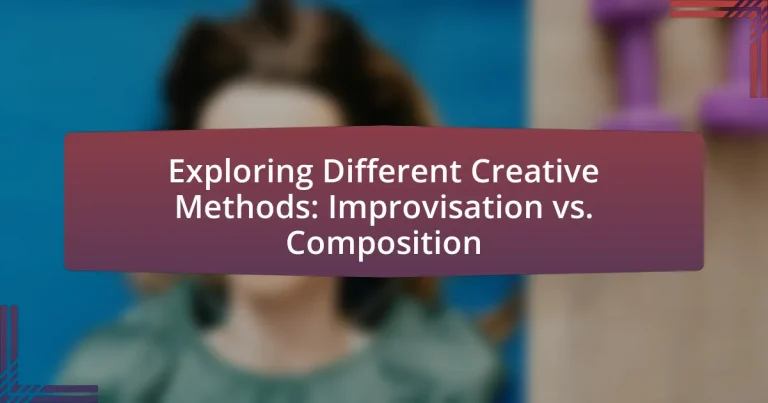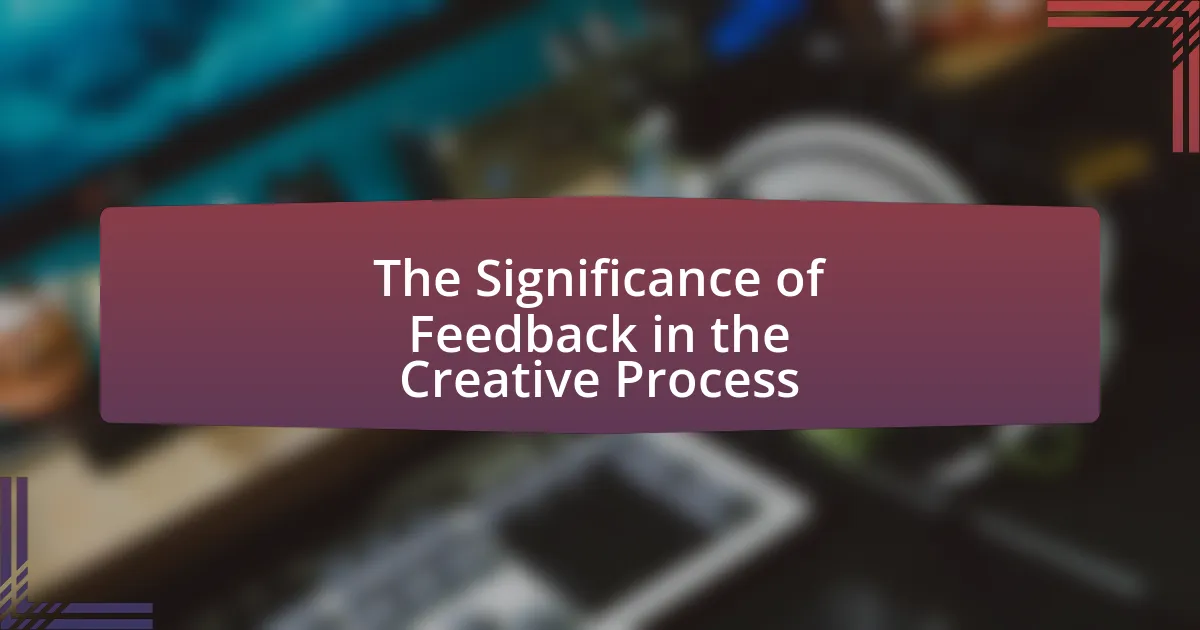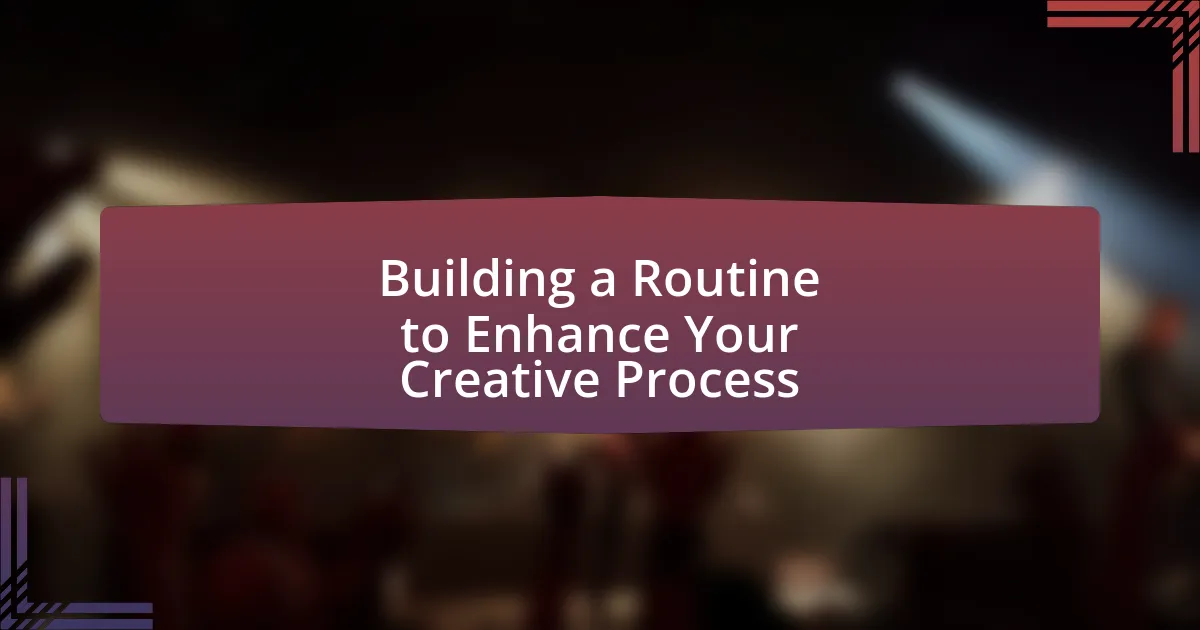The article “Exploring Different Creative Methods: Improvisation vs. Composition” examines the fundamental differences between improvisation and composition as distinct creative processes in music and art. It highlights how improvisation involves spontaneous creation and real-time expression, while composition focuses on structured arrangement and planned development of artistic elements. Key principles of improvisation, such as spontaneity and collaboration, are contrasted with essential elements of composition, including unity and balance. The article also discusses the factors influencing artists’ preferences for either method, the benefits and challenges associated with each approach, and strategies for integrating both improvisation and composition in creative practices.
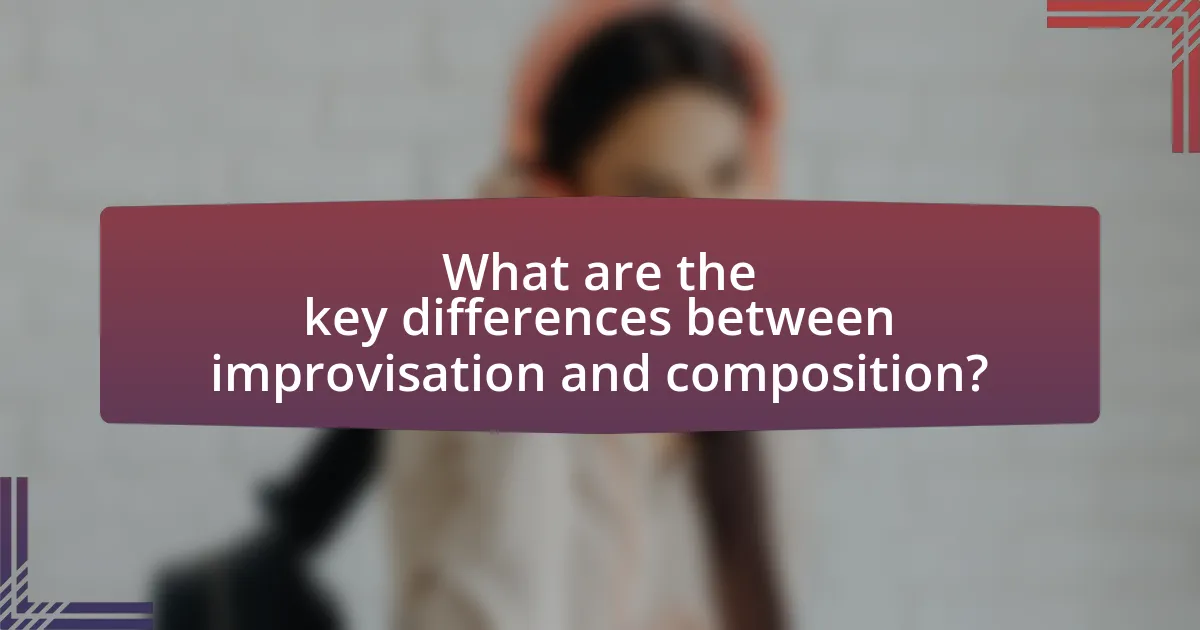
What are the key differences between improvisation and composition?
Improvisation and composition are distinct creative processes in music and art. Improvisation involves spontaneous creation, where artists generate ideas in real-time without premeditated structure, often leading to unique and unpredictable outcomes. In contrast, composition is a planned process that involves the deliberate arrangement of musical or artistic elements, typically resulting in a fixed piece that can be reproduced.
The key difference lies in the approach: improvisation emphasizes immediate expression and adaptability, while composition focuses on structure, form, and the crafting of a cohesive work. Historical examples include jazz musicians who often improvise solos during performances, contrasting with classical composers like Beethoven, who meticulously wrote out their scores in advance.
How do improvisation and composition define creative expression?
Improvisation and composition are fundamental to defining creative expression as they represent two distinct yet complementary approaches to artistic creation. Improvisation allows artists to spontaneously generate ideas and responses in real-time, fostering a sense of freedom and exploration, while composition involves the structured arrangement of ideas, enabling artists to refine and develop their concepts systematically. Historical examples, such as jazz musicians who improvise during performances, illustrate how this spontaneity can lead to unique and innovative expressions. Conversely, classical composers like Johann Sebastian Bach demonstrate how meticulous composition can yield timeless works that convey deep emotional narratives. Together, these methods highlight the spectrum of creative expression, showcasing how both spontaneity and structure contribute to the richness of artistic endeavors.
What are the fundamental principles of improvisation?
The fundamental principles of improvisation include spontaneity, active listening, and collaboration. Spontaneity allows performers to react in the moment, creating unique and unexpected outcomes. Active listening ensures that participants are attuned to each other’s contributions, fostering a cohesive performance. Collaboration emphasizes the importance of working together, where each individual’s input enhances the overall experience. These principles are essential in various forms of improvisation, such as music, theater, and dance, where the dynamic interaction between performers leads to innovative and engaging results.
What are the essential elements of composition?
The essential elements of composition include unity, balance, contrast, emphasis, movement, pattern, and rhythm. Unity ensures that all parts of the composition work together cohesively, while balance distributes visual weight to create stability. Contrast highlights differences to draw attention, and emphasis directs focus to key areas. Movement guides the viewer’s eye through the composition, pattern creates repetition for visual interest, and rhythm establishes a sense of flow. These elements are foundational in various forms of art and design, as they contribute to the overall effectiveness and aesthetic appeal of the work.
Why do artists choose one method over the other?
Artists choose one method over the other based on their creative goals and the desired outcome of their work. For instance, improvisation allows artists to explore spontaneity and express emotions in real-time, which can lead to unique and unexpected results. In contrast, composition provides a structured approach that enables artists to refine their ideas and achieve a specific vision, often resulting in more polished and cohesive pieces. Research indicates that artists often select their methods based on personal preference, the context of the work, and the audience they aim to engage, highlighting the importance of intention in the creative process.
What factors influence the choice between improvisation and composition?
The choice between improvisation and composition is influenced by factors such as the artist’s intent, the context of the performance, and the desired emotional impact. Artists may prefer improvisation for its spontaneity and ability to express immediate emotions, while composition allows for meticulous planning and refinement of ideas. Context plays a crucial role; live performances often favor improvisation to engage audiences dynamically, whereas studio recordings may lean towards composition for clarity and structure. Additionally, the emotional impact desired by the artist can dictate the choice; improvisation may evoke raw, unfiltered feelings, while composition can convey complex narratives through carefully crafted elements.
How do personal styles affect the preference for improvisation or composition?
Personal styles significantly influence the preference for improvisation or composition by shaping an individual’s approach to creativity. Those with a spontaneous and flexible personal style often gravitate towards improvisation, as it allows for immediate expression and exploration of ideas without the constraints of pre-planning. In contrast, individuals with a structured and detail-oriented personal style typically prefer composition, as it involves careful planning, organization, and refinement of ideas. Research indicates that personality traits, such as openness to experience and conscientiousness, correlate with these preferences; for example, a study published in the Journal of Personality and Social Psychology found that individuals high in openness are more likely to engage in improvisational activities, while those high in conscientiousness favor structured composition.
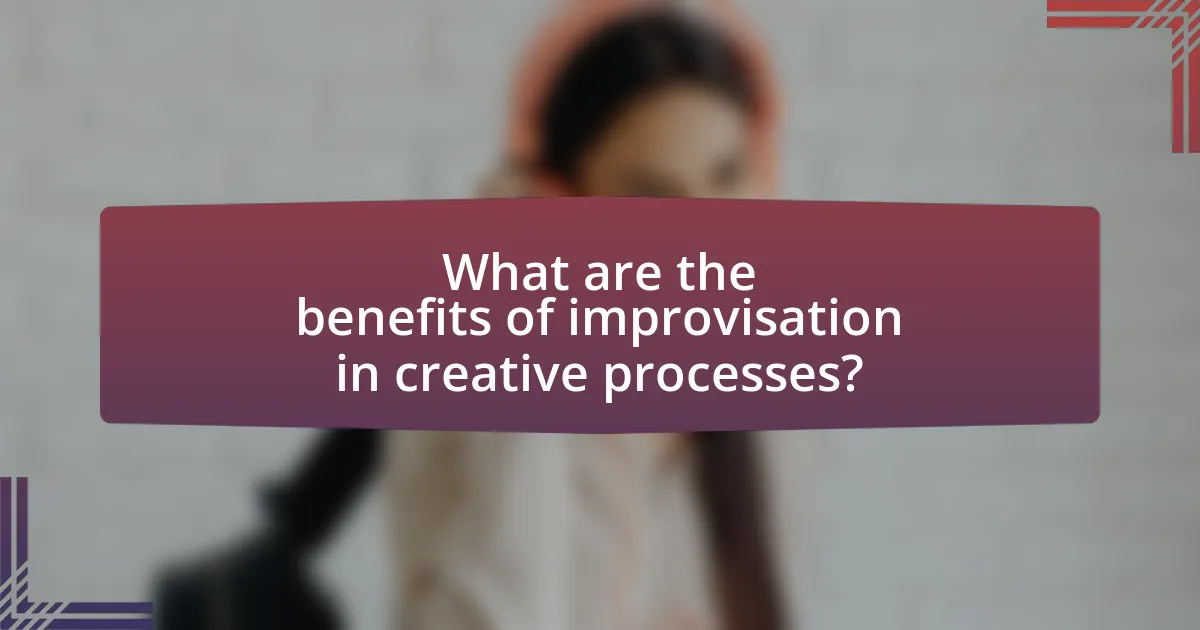
What are the benefits of improvisation in creative processes?
Improvisation in creative processes enhances spontaneity and flexibility, allowing creators to explore new ideas without the constraints of pre-planned structures. This approach fosters innovation, as it encourages individuals to think outside the box and respond to unexpected challenges in real-time. Research indicates that improvisation can lead to increased collaboration and communication among team members, as it requires active listening and adaptability. For instance, a study published in the Journal of Creative Behavior found that improvisational techniques in group settings significantly improved creative output and problem-solving abilities.
How does improvisation enhance creativity?
Improvisation enhances creativity by fostering spontaneous thinking and encouraging the exploration of new ideas without the constraints of pre-planned structures. This process allows individuals to break free from conventional thought patterns, leading to innovative solutions and artistic expressions. Research indicates that improvisational practices, such as those used in jazz music or theater, stimulate brain activity associated with creativity, as evidenced by studies showing increased activation in the prefrontal cortex during improvisational tasks. This heightened brain engagement facilitates the generation of unique concepts and the ability to adapt quickly to changing circumstances, ultimately enriching the creative process.
What skills are developed through improvisational practices?
Improvisational practices develop several key skills, including adaptability, creativity, collaboration, and quick thinking. Adaptability is essential as individuals learn to respond to unexpected changes and challenges in real-time. Creativity is enhanced through the exploration of spontaneous ideas and expressions, allowing for innovative thinking. Collaboration skills are fostered as participants engage with others, requiring effective communication and teamwork. Quick thinking is crucial, as improvisation demands immediate decision-making and problem-solving abilities. These skills are supported by research indicating that improvisational activities enhance cognitive flexibility and social interaction, which are vital in various personal and professional contexts.
How does improvisation foster collaboration among artists?
Improvisation fosters collaboration among artists by encouraging spontaneous interaction and mutual responsiveness. This dynamic allows artists to build on each other’s ideas in real-time, creating a shared creative space where contributions are valued and integrated. Research indicates that improvisational practices, such as those used in jazz ensembles, enhance communication skills and promote trust among participants, leading to more cohesive artistic outcomes. For instance, a study by Sawyer (2006) in “Group Creativity: Music, Theater, Collaboration” highlights how improvisation facilitates a flow of ideas that strengthens group cohesion and innovation.
What challenges do artists face when improvising?
Artists face several challenges when improvising, including the pressure to create spontaneously, the risk of self-criticism, and the need for technical proficiency. The spontaneity required in improvisation can lead to anxiety, as artists may fear that their ideas will not meet their own or others’ expectations. Additionally, self-criticism can hinder creativity, causing artists to second-guess their choices in real-time. Technical proficiency is also crucial; without a solid foundation in their craft, artists may struggle to express their ideas effectively during improvisation. These challenges are supported by research indicating that performance anxiety and self-doubt are common among artists, impacting their ability to improvise successfully.
How can artists overcome the fear of failure in improvisation?
Artists can overcome the fear of failure in improvisation by reframing their mindset to view mistakes as opportunities for growth. This shift in perspective allows artists to embrace spontaneity and creativity without the pressure of perfection. Research indicates that a growth mindset, as described by psychologist Carol Dweck, fosters resilience and encourages individuals to learn from their experiences rather than fear them. By practicing regularly in low-stakes environments, artists can build confidence and reduce anxiety associated with improvisation, ultimately enhancing their creative expression.
What strategies can improve improvisational skills?
To improve improvisational skills, individuals can practice active listening, engage in spontaneous exercises, and embrace a mindset of experimentation. Active listening enhances responsiveness and adaptability, allowing performers to react effectively to their environment and collaborators. Spontaneous exercises, such as “yes, and” techniques in improvisational theater, encourage quick thinking and creativity by building on ideas without judgment. Embracing experimentation fosters a willingness to take risks and learn from mistakes, which is essential for growth in improvisation. Research indicates that consistent practice in these areas leads to increased confidence and proficiency in improvisational settings.
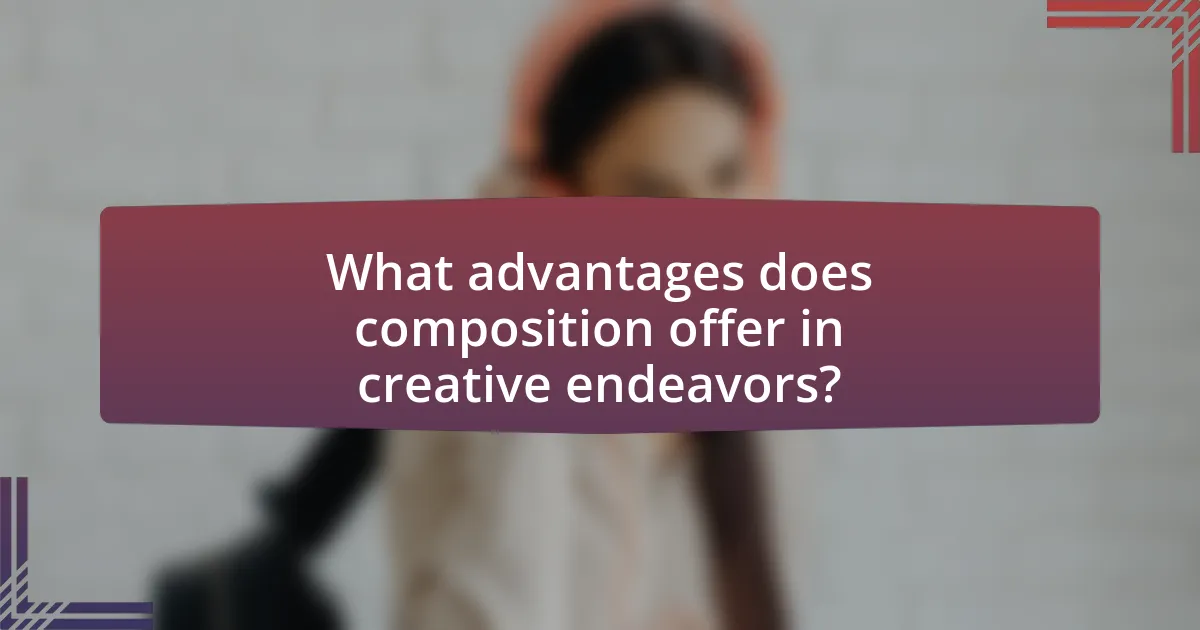
What advantages does composition offer in creative endeavors?
Composition provides structure and intentionality in creative endeavors, allowing artists to organize their ideas effectively. This structured approach enhances clarity and coherence, making it easier for audiences to engage with the work. Research indicates that structured composition can lead to improved creativity; for instance, a study published in the Journal of Creative Behavior found that individuals who utilized compositional frameworks produced more innovative outcomes compared to those who relied solely on improvisation. Thus, the advantages of composition include enhanced clarity, improved audience engagement, and increased creative output.
How does composition provide structure to creative works?
Composition provides structure to creative works by establishing a framework that organizes ideas, themes, and elements systematically. This structured approach allows creators to develop their concepts coherently, ensuring that each component serves a purpose within the overall narrative or artistic expression. For example, in music, composition involves arranging notes and rhythms in a way that creates a cohesive piece, while in literature, it includes structuring plots and character arcs to enhance storytelling. The effectiveness of composition in providing structure is evident in various art forms, where a well-defined framework leads to clarity and engagement for the audience.
What are the stages involved in the composition process?
The stages involved in the composition process are typically outlined as prewriting, drafting, revising, editing, and publishing. Prewriting involves brainstorming and organizing ideas, which sets the foundation for the composition. Drafting is the stage where the writer creates the initial version of the text, focusing on getting ideas down without worrying about perfection. Revising follows, where the writer reviews and makes substantial changes to improve content and structure. Editing is the next step, concentrating on correcting grammar, punctuation, and style. Finally, publishing is the stage where the completed work is shared with an audience. These stages are widely recognized in writing pedagogy, as they provide a structured approach to developing effective written communication.
How does composition allow for detailed expression of ideas?
Composition allows for detailed expression of ideas by providing a structured framework that organizes thoughts and themes systematically. This structure enables the creator to develop complex narratives, articulate nuanced arguments, and explore intricate concepts in depth. For instance, in written composition, the use of outlines and drafts facilitates the refinement of ideas, ensuring clarity and coherence, which enhances the overall message. Research indicates that structured writing processes lead to improved cognitive organization, allowing for more sophisticated expression of ideas (Graham & Perin, 2007, “A Meta-Analysis of the Effectiveness of Writing Instruction”).
What limitations might artists encounter in composition?
Artists may encounter several limitations in composition, including constraints related to technical skills, creative blocks, and external pressures. Technical skills can limit an artist’s ability to translate their ideas into a cohesive composition, as evidenced by studies showing that proficiency in tools and techniques directly impacts artistic output. Creative blocks, often stemming from self-doubt or fear of judgment, can hinder the flow of ideas, which is supported by psychological research indicating that anxiety can stifle creativity. Additionally, external pressures such as deadlines or audience expectations can restrict an artist’s freedom to explore their vision fully, as noted in surveys where artists reported feeling constrained by commercial demands.
How can rigidity in composition stifle creativity?
Rigidity in composition can stifle creativity by limiting the freedom to explore new ideas and approaches. When strict rules and structures dominate the creative process, individuals may feel constrained, leading to a lack of innovation and original thought. Research indicates that environments that encourage flexibility and experimentation foster greater creative output, as seen in studies by Amabile (1996) which highlight the importance of intrinsic motivation and freedom in enhancing creativity. Thus, a rigid compositional framework can inhibit the natural flow of creative expression, ultimately resulting in less imaginative work.
What techniques can help maintain flexibility in composition?
Techniques that can help maintain flexibility in composition include improvisation, iterative drafting, and the use of modular structures. Improvisation allows composers to explore spontaneous ideas, fostering creativity and adaptability. Iterative drafting encourages revisiting and revising work, which can lead to new insights and adjustments. Modular structures enable composers to rearrange sections easily, facilitating changes without overhauling the entire piece. These techniques are supported by research indicating that flexibility in creative processes enhances overall artistic expression and innovation.
How can artists effectively integrate improvisation and composition?
Artists can effectively integrate improvisation and composition by establishing a framework that allows for spontaneous creativity within structured guidelines. This approach enables artists to explore new ideas while maintaining coherence in their work. For instance, musicians often use a composed melody as a foundation, allowing for improvisational solos that enhance the overall piece without losing its original intent. Research indicates that this blend can lead to innovative outcomes, as seen in jazz, where musicians balance pre-composed elements with improvisational freedom, resulting in unique performances that still adhere to a recognizable form.
What are the benefits of blending improvisation with composition?
Blending improvisation with composition enhances creativity and flexibility in artistic expression. This combination allows artists to explore spontaneous ideas while maintaining structure, leading to innovative outcomes. For instance, jazz musicians often use improvisation within composed frameworks, resulting in unique performances that retain coherence while showcasing individual creativity. Research indicates that this approach can stimulate cognitive processes, fostering problem-solving skills and adaptability in various artistic disciplines.
How can artists transition between improvisation and composition in their work?
Artists can transition between improvisation and composition by developing a flexible creative process that incorporates elements of both practices. This can be achieved through techniques such as setting specific constraints during improvisation to guide the creative flow, which can later be refined into structured compositions. For instance, jazz musicians often use improvisational solos that are later transcribed and arranged into formal pieces, demonstrating a clear pathway from spontaneous creation to composed work. Additionally, artists can record improvisational sessions and analyze them to identify themes or motifs that can be expanded into composed pieces, effectively bridging the gap between the two methods.
